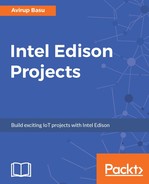Book Description
Build powerful Robots and IoT solutions using Intel Edison
About This Book
- Learn to build advanced level robots with Intel Edison and Arduino
- Efficiently build and program home automation and IoT projects with Intel Edison
- Master the skills of creating enticing projects with Intel Edison.
Who This Book Is For
If you are a hobbyist, robot engineer, IoT enthusiast, programmer, or developer who wants to create autonomous projects with Intel Edison, then this book is for you. Prior programming knowledge would be beneficial.
What You Will Learn
- Program your device using the Arduino processor language, Python, and Node.js
- Interface different sensors with the Intel Edison
- Build a home automation system using MQTT, Android, and WPF
- Perform face detection using Intel Edison
- Develop a high-speed line follower robot
- Control a robot using a PC application and an custom controller
In Detail
Change the way you look at embedded electronics with Intel Edison. It is a small computing platform packed with a set of robust features to deliver hands-on performance, durability, and software support.
This book is a perfect place to kickstart development and rapid prototyping using Intel Edison. It will start by introducing readers to the Intel Edison board and explaining how to get started with it. You will learn how to build a mini weather station, which will help you to acquire temperature and smoke level and push it to the IoT platform. Then you will see how to build a home automation device and control your appliances using an Android app. Furthermore, we will build a security system using a webcam to detect faces and perform voice recognition. Toward the end, the book will demonstrate how you can build two robots, which will be based on different line sensing sensors and can be controlled by a PC.
The book will guide the readers through each and every step of execution of a project, using Intel Edison.
Style and approach
A project-based guide that will take the readers through various domains of projects like robotics, IoT and so on.
Downloading the example code for this book. You can download the example code files for all Packt books you have purchased from your account at http://www.PacktPub.com. If you purchased this book elsewhere, you can visit http://www.PacktPub.com/support and register to have the code file.
Table of Contents
- About the Author
- About the Reviewer
- Preface
- Setting up Intel Edison
- Weather Station (IoT)
- Overview of IoT and its usage
- Architecture of a typical IoT project
- Interfacing sensors with Intel Edison
- Explanation of the code
- Connecting the device and uploading to the cloud (dweet.io)
- Live use case of an IoT project - mini weather station
- Architecture of the system
- Hardware components and detailed circuit diagram
- Code for weather station stage 1, acquiring data from all the sensors and displaying it in the console
- Open-ended task for the reader
- Summary
- Overview of IoT and its usage
- Intel Edison and IoT (Home Automation)
- Controlling devices using the Internet - concepts
- REST services
- Instructions or alerts (present on most IoT platforms)
- Architecture
- Using Intel Edison to push data by using the MQTT protocol
- Getting data to Edison by using MQTT
- Home automation using Intel Edison, MQTT, Android, and WPF
- Android application for controlling Intel Edison using MQTT
- Windows Presentation Foundation application for controlling using MQTT
- Open-ended task for the reader
- Summary
- Intel Edison and Security System
- Autonomous Robotics with Intel Edison
- Architecture of a typical robotic system
- Intel Edison as a controller
- Connecting sensors to the Intel Edison
- Actuators - DC motors and servos
- More advanced motor drivers
- Line follower robot (patching everything together)
- Proportional integral derivative - based control
- Open-ended question for the reader
- Summary
- Manual Robotics with Intel Edison
